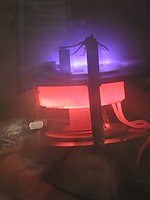
Photo from wikipedia
The chemical vapor deposition (CVD) of graphene on liquid substrates produces high quality graphene films due to the defect-free and atomically flat surfaces of the liquids. Through the detailed study… Click to show full abstract
The chemical vapor deposition (CVD) of graphene on liquid substrates produces high quality graphene films due to the defect-free and atomically flat surfaces of the liquids. Through the detailed study of graphene growth on liquid Sn using atmospheric pressure CVD (APCVD), the quality of graphene has been found to have a close relationship with hydrogen flow rate that reflects on hydrogen partial pressure inside the reactor (PH2) and hydrogen solubility of the growth substrates. The role of PH2 was found to be crucial, with a low defect density monolayer graphene being obtained in low PH2 (90.4 mbar), while partial graphene coverage occurred at high PH2 (137.3 mbar). To further understand the role of substrate’s composition, binary alloy with compositions of 20, 30, 50, 60 and 80 wt.% tin in copper were made by arc-melting. Graphene quality was found to decrease with increasing the content of copper in the Cu–Sn alloys when grown using the conditions optimised for Sn substrates and this was related to the change in hydrogen solubility and the high catalytic activity of Cu compared to Sn. This shall provide a tool to help optimising CVD conditions for graphene growth based on the properties of the used catalytic substrate.
Journal Title: Nanomaterials
Year Published: 2020
Link to full text (if available)
Share on Social Media: Sign Up to like & get
recommendations!